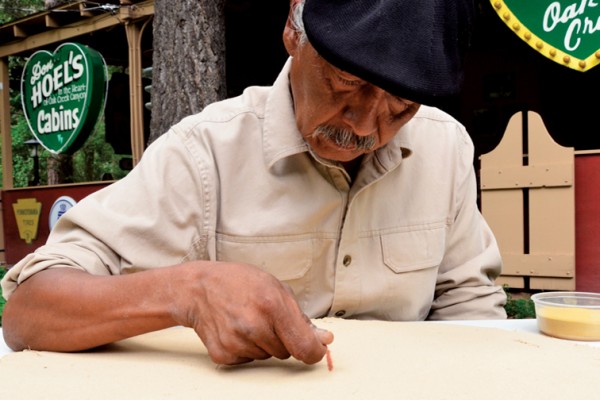Continued (page 3 of 4)
No God, No Master: David Strathairn
David Strathairn’s name might not be immediately familiar, but you’re sure to recognize his face. His filmography includes everything from The Bourne Ultimatum and The Bourne Legacy to The Notorious Bettie Page and, most recently, Steven Spielberg’s Lincoln. He received an Academy Award nomination for his role as Edward Murrow in George Clooney’s Good Night, and Good Luck, but David is also passionate about indie films. He plays the lead role in No God, No Master, which is being screened at SIFF. He spoke to us from New York where he was starring opposite Jessica Chastain in Broadway’s The Heiress.
Sedona Monthly: How did you become involved with No God, No Master?
David Strathairn: I had worked with Terry [Green] previously on Heaven’s Fall. When he called me about this one, we had the usual read, respond and talk. I thought he was on to something with an event in American history that parallels some of the present concerns about international or domestic acts of violence with political motivation behind them. I thought it was an interesting way to get the conversation going about the issue, and it’s a very interesting chapter in American history that not too many people are aware of.
What’s your impression of the final film?
I think it’s handsomely done – really well accomplished considering the budget. The production values are pretty admirable. [Terry] covers a lot of territory with these characters. It’s more of a historical drama rather than an actual action-thriller drama, and I like it from that point of view.
In the course of 24 days, you shot in 42 different locations. As an actor, how difficult is that?
People look at this film and can’t believe we shot in 24 days. Hats off to Terry. It was much more of a concern from a production end than from my end – we follow the production trucks around. They are the elephants that set up the circus, and then the clowns come in.
Your repertoire runs the gamut from indies like No God, No Master to the latest Steven Spielberg blockbuster, Lincoln. Can you compare and contrast the two?
They are both dealing with incidents in American history that were pivots in many ways. The films are part and parcel of America’s political and cultural history, and they each do well telling the story on their own. There was so much going on in our country in 1919 and 1920. I’ve done a couple of pictures dealing with that time – John Sayles’ Matewan and Eight Men Out. For Terry to add another window into that time is great. Of course, Steven has whatever he wants and whatever he needs to make it happen. Both films stand tall on their own particular legs, but if you have the machine and the wherewithal that Spielberg has built for himself, it creates a road that doesn’t have as many speed bumps as we encountered with No God, No Master.
As an Academy Award nominee, why still make independent films?
It comes down to the subject matter – the stories being told – and whether or not I have the opportunity to get in line for one of the parts. I like films that I would go see, films that I would learn from, something that I think will illuminate things that aren’t readily available to the public. It’s hard to make a film that everyone is going to like, but I tend to gravitate toward projects that are going to teach me something, whether it’s historical, cultural or psychological. I like stories with an ensemble feeling with a large tapestry of people.
Was filming Good Night, and Good Luck a career high point?
Yes. It was such a challenging role considering all of the eye beams attached to it given George’s [Clooney] reputation and the subject matter. I knew that would bring a lot of attention. It ended up being a really extraordinary experience. Day to day, it was a lot of fun. You often don’t get projects as well oiled and focused.
What is the importance of film festivals today?
The amount of film festivals springing up everywhere go hand in hand with the amount of product that’s out there and the number of filmmakers. The more film festivals there are, the more opportunity for artists to show their work. It’s a great phenomenon. Often festivals are the only places to see these films before they go to DVD. Film festivals have their own personalities, too. It’s a communal celebration of the artist and the industry.
Have you ever been to Sedona?
I’ve been through Sedona – I was hitchhiking across the Southwest on my way up to Four Corners. It’s so beautiful. What a great place for a film festival.
So one last question. Before you seriously began to pursue acting, you joined Ringling Bros. and Barnum & Bailey Clown College and worked with a traveling circus. Give our readers insight into clown college.
[Laughs] That’s a whole other 1,200 words. I have very few insights. It was the first year that clown college existed. I sort of learned how to fall down and not hurt myself.
No God, No Master: Terry Green
For many filmgoers, No God, No Master, the latest feature film by Terry Green, is a history lesson. The film covers the early days of the anarchist movement, the 1920 bombing of Wall Street and the Sacco and Vanzetti trial, all through the eyes of U.S. Bureau of Investigation agent William Flynn (played by Academy Award nominee David Strathairn). The SIFF screening of the film – the first time it’s been shown in Arizona – should make for a lively Q&A considering the film’s immigration theme. Terry spoke with us from Chicago about what it was like to make a period film on an indie budget.
Sedona Monthly: Why did you feel it was important to make a film about the Sacco and Vanzetti case?
Terry Green: My company produces films on famous legal cases and socially relevant issues. I always wanted to make a movie about the Sacco and Vanzetti case, but I didn’t want to make another courtroom drama. As I researched [Sacco and Vanzetti], I found out that they dedicated their lives to the advancement of an anarchist cause, and specifically a very violent one. That interested me. As I researched, I learned about investigator William Flynn. Not much is known about him, so I decided to tell the story through him. This was all done over a period to two or three years, and it begin during the Bush-Cheney years. I thought it was interesting that 90 some odd years ago, government’s overreach dictated a lot of agendas and policy. History unchecked tends to repeat itself. A lot of people don’t even realize there was a bombing on Wall Street in the summer of 1920. So it was similar to some of our contemporary issues.
For an audience living in a state where immigration is such a hot-button issue, how do you think people will react to the film?
The labor issue is very prominent in the state of Wisconsin, where the movie has played, and during a Q&A in front of a sold-out audience of 1,100 people a few months ago, we had a very interesting discussion. I expect the Sedona Q&A might center around the immigration issue. On one hand, I am a political filmmaker, but on the other hand, I just want to make films that resonate with contemporary audiences. I make these types of films to spark discussion, but these are hard movies to produce and these are hard movies to get out to the general public. If you have the power to make a movie, you ought to make a movie that says something and stands the test of time.
Was it difficult to make the film?
Financing is difficult for any independent film. The market has changed so drastically in the last four or five years in terms of distribution. It costs $7 million to make this film. It’s harder and harder to get a movie to market unless you’re technically savvy, though film festivals are the most valid avenue toward distribution. The people who are involved in my films – my last two films were financed by lawyers – understand that there is a risk, but they’re involved because these films register emotionally with them. My company finances every dime; we’ve never taken a nickel from Hollywood. The only thing that held us back was that we had relied on a tax incentive in the state of Wisconsin where we shot the film. It was repealed while we were filming, which caused us to have to go back and raise $800,000. That was a huge blow to the production.
What were you doing before you were making movies?
I started as a stage actor. I made my living in the theater in Chicago for several years. I attended the Goodman School of Drama [now the Theatre School at DePaul University] and worked in the theater for 10 years before I decided to become a filmmaker. One of the things I love is working with actors, and I tend to attract the good ones. I have had Academy Award winners or nominees in all of the films I have directed, and I’m very proud of that. Part of that is because I think I know how actors function and how they think. I’ve directed David Strathairn in two films.
So your budget for this film was $7 million. That’s high for an indie film but very low for a period piece.
It is high for an independent film these days – most are made for $2 to $4 million. If I was HBO, and I was shooting Boardwalk Empire, I’d have $30 or $40 million. When you are shooting a period piece, and you move your camera 10 feet to the left of right, you’re no longer in 1919; you’re in 2011. And we had over 600 costumes in a big trailer, and we had 70 picture cars on reserve. Period movies are very challenging, and I don’t want to make another one right away because they are so challenging. We shot 42 locations in Wisconsin in 24 days. You really need about 40 days to make a movie like this, and we did it in 24.



